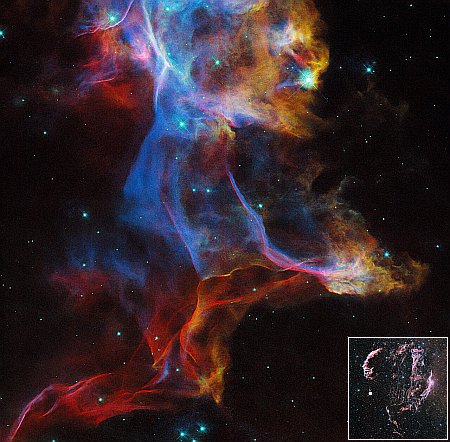Hubble takes a close look at one tiny part of the Veil Nebula
Cool image time! The picture to the right, reduced and sharpened to post here, was taken by the Hubble Space Telescope of just one very tiny section of the supernova remnant known as the Veil Nebula, located about 2,400 light years away.
The white dot on the inset (showing the entire Veil Nebula) marks the area covered by this closeup, focused on the one bright section of nebula in the Veil’s southwest quadrant. From the caption:
This nebula is the remnant of a star roughly 20 times as massive as the Sun that exploded about 10 000 years ago. … This view combines images taken in three different filters by Hubble’s Wide Field Camera 3 instrument, highlighting emission from hydrogen, sulphur and oxygen atoms. This image shows just a small fraction of the Veil Nebula; if you could see the entire nebula without the aid of a telescope, it would be as wide as six full Moons placed side by side.
Astronomers have been using Hubble to take periodic pictures of the Veil Nebular since 1994 in order to track changes as these gaseous gossamer strands evolve over time.
On Christmas Eve 1968 three Americans became the first humans to visit another world. What they did to celebrate was unexpected and profound, and will be remembered throughout all human history. Genesis: the Story of Apollo 8, Robert Zimmerman's classic history of humanity's first journey to another world, tells that story, and it is now available as both an ebook and an audiobook, both with a foreword by Valerie Anders and a new introduction by Robert Zimmerman.
The print edition can be purchased at Amazon or from any other book seller. If you want an autographed copy the price is $60 for the hardback and $45 for the paperback, plus $8 shipping for each. Go here for purchasing details. The ebook is available everywhere for $5.99 (before discount) at amazon, or direct from my ebook publisher, ebookit. If you buy it from ebookit you don't support the big tech companies and the author gets a bigger cut much sooner.
The audiobook is also available at all these vendors, and is also free with a 30-day trial membership to Audible.
"Not simply about one mission, [Genesis] is also the history of America's quest for the moon... Zimmerman has done a masterful job of tying disparate events together into a solid account of one of America's greatest human triumphs."--San Antonio Express-News
Cool image time! The picture to the right, reduced and sharpened to post here, was taken by the Hubble Space Telescope of just one very tiny section of the supernova remnant known as the Veil Nebula, located about 2,400 light years away.
The white dot on the inset (showing the entire Veil Nebula) marks the area covered by this closeup, focused on the one bright section of nebula in the Veil’s southwest quadrant. From the caption:
This nebula is the remnant of a star roughly 20 times as massive as the Sun that exploded about 10 000 years ago. … This view combines images taken in three different filters by Hubble’s Wide Field Camera 3 instrument, highlighting emission from hydrogen, sulphur and oxygen atoms. This image shows just a small fraction of the Veil Nebula; if you could see the entire nebula without the aid of a telescope, it would be as wide as six full Moons placed side by side.
Astronomers have been using Hubble to take periodic pictures of the Veil Nebular since 1994 in order to track changes as these gaseous gossamer strands evolve over time.
On Christmas Eve 1968 three Americans became the first humans to visit another world. What they did to celebrate was unexpected and profound, and will be remembered throughout all human history. Genesis: the Story of Apollo 8, Robert Zimmerman's classic history of humanity's first journey to another world, tells that story, and it is now available as both an ebook and an audiobook, both with a foreword by Valerie Anders and a new introduction by Robert Zimmerman.
The print edition can be purchased at Amazon or from any other book seller. If you want an autographed copy the price is $60 for the hardback and $45 for the paperback, plus $8 shipping for each. Go here for purchasing details. The ebook is available everywhere for $5.99 (before discount) at amazon, or direct from my ebook publisher, ebookit. If you buy it from ebookit you don't support the big tech companies and the author gets a bigger cut much sooner.
The audiobook is also available at all these vendors, and is also free with a 30-day trial membership to Audible.
"Not simply about one mission, [Genesis] is also the history of America's quest for the moon... Zimmerman has done a masterful job of tying disparate events together into a solid account of one of America's greatest human triumphs."--San Antonio Express-News



Bob:
When I am looking at a spectacular image like this, what is it I am actually observing? Is it “particles?” Frequencies of photons? Dust? Radiated energy? All of the above?
As you can likely tell from my questions, I am way above my pay grade, though NOT my curiosity and fascination? Thank you for whatever answers you may choose to provide to what amount to endless questions triggering an expanding universe of them!
Dave Walden: It is my understanding that the colors represent the emissions from hydrogen, sulphur and oxygen atoms, as mentioned in the caption. In this sense this is not a real image, but a enhanced color one, matching reality but significantly adjusted.
The nebula is likely all the things you mention, dust, radiated energy, etc, all originally thrown out from the star when it went supernova. The enhancements simply make it appear more substantial than it is.